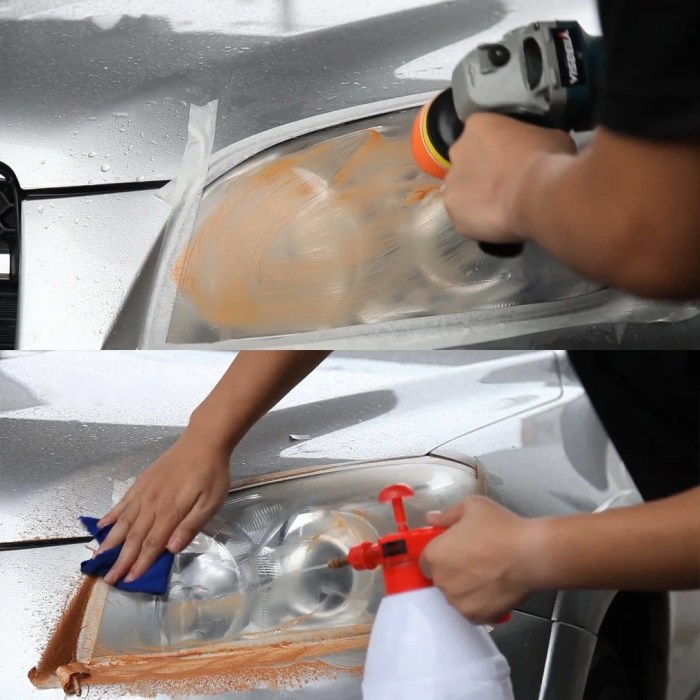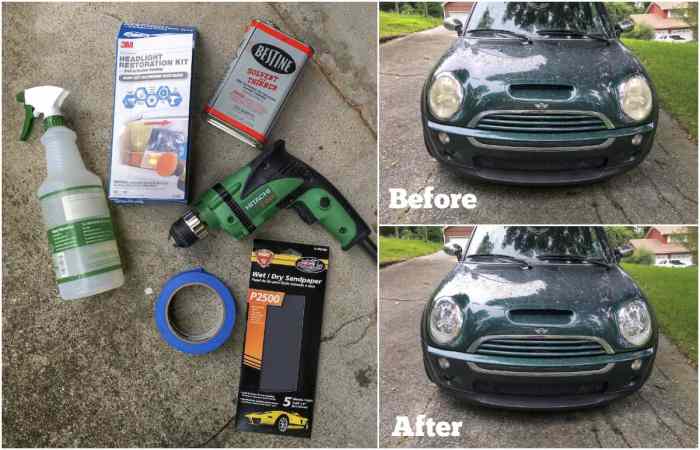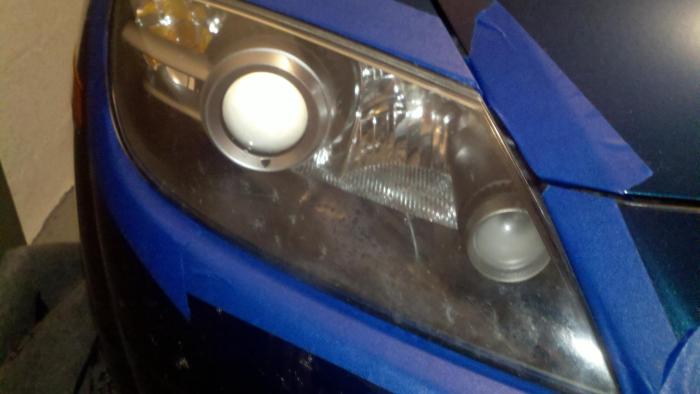DIY Headlamp Restoration: Bring Back Your Car’s Shine – Have you ever noticed your car’s headlights looking cloudy or yellowed? This common problem not only affects your car’s aesthetics but also significantly reduces nighttime visibility. The culprit behind this deterioration is often UV exposure and environmental factors that cause the plastic lens to degrade over time. But don’t despair! You can restore your headlights to their former glory with a simple DIY restoration project. This guide will walk you through the process, from identifying the severity of the damage to applying protective coatings to ensure long-lasting results.
This article will provide a step-by-step guide on how to restore your car’s headlights using common household items and readily available tools. We’ll cover everything from the basics of headlamp degradation to advanced techniques for achieving a professional-looking finish. Whether you’re a seasoned mechanic or a DIY enthusiast, this guide will equip you with the knowledge and confidence to tackle this project with ease.
Understanding Headlamp Degradation: Diy Headlamp Restoration

Headlights are essential for safe driving, especially at night or in low-visibility conditions. Over time, they can become cloudy or yellowed, reducing their effectiveness and potentially compromising your safety. Understanding the causes of this degradation is crucial for maintaining optimal headlamp performance and ensuring a clear view of the road ahead.
Common Causes of Headlamp Clouding and Yellowing
The deterioration of headlamps is primarily caused by a combination of factors, including exposure to ultraviolet (UV) radiation, environmental elements, and the natural aging process of the headlamp materials.
- UV Radiation: Sunlight contains UV rays that can damage the polycarbonate plastic used in modern headlamps. This exposure leads to the breakdown of the plastic’s molecular structure, causing it to become brittle, cloudy, and discolored.
- Environmental Factors: Exposure to environmental elements such as rain, snow, ice, and road grime can also contribute to headlamp degradation. These elements can etch the headlamp surface, creating microscopic scratches that scatter light and reduce visibility.
- Aging: Over time, the plastic used in headlamps naturally degrades, becoming more susceptible to clouding and yellowing. This process is accelerated by exposure to UV radiation and environmental elements.
Impact of UV Exposure and Environmental Factors
UV exposure and environmental factors play a significant role in the deterioration of headlamps.
- UV Radiation: UV radiation is a primary cause of headlamp degradation. The sun’s UV rays break down the molecular structure of the polycarbonate plastic, leading to yellowing, clouding, and a decrease in light output. This degradation is particularly noticeable in areas with high levels of sunlight exposure.
- Environmental Factors: Exposure to rain, snow, ice, and road grime can also accelerate headlamp deterioration. These elements can etch the headlamp surface, creating microscopic scratches that scatter light and reduce visibility. Road salt, in particular, is known to be highly corrosive and can significantly damage headlamps.
Identifying the Severity of Headlamp Degradation
The severity of headlamp degradation can vary depending on the factors mentioned above.
- Mild Degradation: Mild degradation is characterized by a slight haze or yellowing on the headlamp surface. Light output may be slightly reduced, but overall visibility is not significantly compromised.
- Moderate Degradation: Moderate degradation is characterized by noticeable clouding or yellowing, and the light output is significantly reduced. Visibility may be compromised, especially in low-light conditions.
- Severe Degradation: Severe degradation is characterized by significant clouding, yellowing, or even cracking of the headlamp surface. Light output is severely reduced, and visibility is significantly compromised.
Safety Precautions

Restoring your headlights involves working with abrasive compounds and potentially harsh chemicals. It’s crucial to prioritize safety throughout the process to avoid any injuries or health issues.
Personal Protective Equipment
Wearing appropriate personal protective equipment (PPE) is essential when handling abrasive compounds and chemicals. These substances can irritate your skin, eyes, and respiratory system.
- Gloves: Wear heavy-duty gloves that are resistant to chemicals and abrasives. Nitrile gloves are a good choice for most applications.
- Eye Protection: Always wear safety glasses or goggles to protect your eyes from flying debris and chemical splashes.
- Respiratory Protection: If you are working in an enclosed space or with particularly harsh chemicals, consider using a respirator mask. This will prevent you from inhaling harmful fumes.
- Clothing: Wear old clothes that you don’t mind getting dirty. Avoid wearing loose clothing that could get caught in tools or machinery.
Handling Abrasive Compounds and Chemicals
When working with abrasive compounds and chemicals, it’s important to follow these safety guidelines:
- Read the labels carefully: Always read the manufacturer’s instructions and safety data sheets (SDS) before using any abrasive compound or chemical. This will provide information on potential hazards, proper handling, and first aid procedures.
- Work in a well-ventilated area: Ensure adequate ventilation to minimize exposure to fumes and dust. If you are working indoors, open windows and doors to allow fresh air to circulate.
- Avoid contact with skin and eyes: Wear appropriate PPE and avoid direct contact with abrasive compounds and chemicals. If accidental contact occurs, immediately flush the affected area with plenty of water and seek medical attention if necessary.
- Store materials properly: Store abrasive compounds and chemicals in their original containers and in a cool, dry place away from heat and direct sunlight. Keep them out of reach of children and pets.
Disposal of Used Materials, Diy headlamp restoration
Proper disposal of used abrasive compounds and chemicals is crucial to prevent environmental contamination.
- Check local regulations: Contact your local waste disposal authority or environmental agency for guidance on the proper disposal of used materials.
- Never pour chemicals down the drain: Many abrasive compounds and chemicals are harmful to the environment and can damage plumbing.
- Dispose of materials in designated containers: Use separate containers for different types of waste, such as plastic, metal, and hazardous materials.
- Label containers clearly: Clearly label containers with the type of waste they contain to avoid confusion and potential hazards.
Maintenance and Prevention

Just like any other car part, restored headlamps need proper care to maintain their optimal performance and longevity. Following a few simple steps can significantly extend the lifespan of your restored headlamps and keep them shining bright.
Regular Cleaning and Inspection
Regular cleaning and inspection are crucial for maintaining the clarity and performance of your headlamps.
- Dust and debris: A gentle cleaning with a microfiber cloth and a mild soap solution can remove dust, dirt, and grime that can obscure the light output. Avoid using harsh chemicals or abrasive cleaners that could damage the lens surface.
- Insect splatters: Insect splatters can quickly accumulate on the headlamp lens, reducing light penetration. Use a dedicated bug and tar remover to clean these stubborn stains. A soft bristle brush can help loosen stubborn residue.
- Scratches and abrasions: While regular cleaning can prevent scratches, it’s essential to inspect your headlamps for any existing scratches or abrasions. Minor scratches can be buffed out using a headlight restoration kit or a specialized polishing compound. However, for deeper scratches, professional repair might be necessary.
- Internal moisture: Check for any signs of moisture inside the headlamp housing. If moisture is present, it’s crucial to address the issue promptly to prevent further damage to the internal components.
Restoring your car’s headlights is a rewarding DIY project that can significantly enhance your car’s appearance and safety. By following the steps Artikeld in this guide, you can achieve professional-looking results without breaking the bank. Remember, regular maintenance and preventative measures can help extend the lifespan of your restored headlights, ensuring optimal visibility and a sleek look for years to come. So, grab your tools, gather your materials, and get ready to bring back the shine to your car’s headlights!
Restoring your car’s headlamps can be a rewarding DIY project, especially if you’re dealing with cloudy or yellowed lenses. Similar to how a medication like metoprolol succinate er can help regulate your heart rate, a thorough headlamp restoration can significantly improve your nighttime visibility and overall driving safety. By removing the oxidation and restoring the clarity of your lenses, you’ll not only enhance your car’s aesthetics but also ensure that you can see and be seen more clearly on the road.
